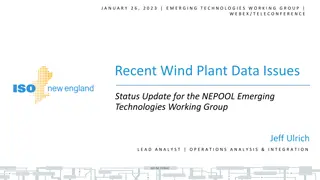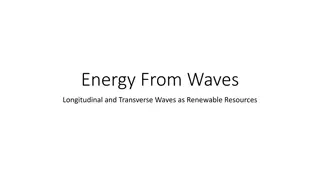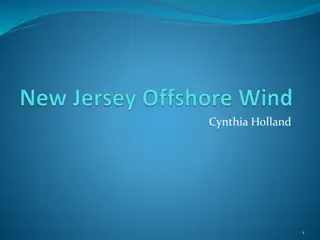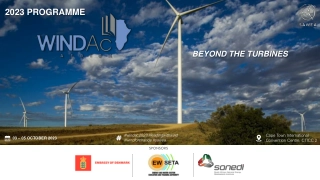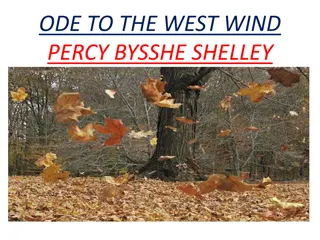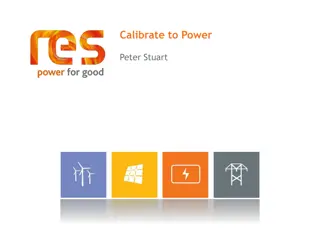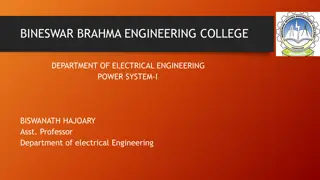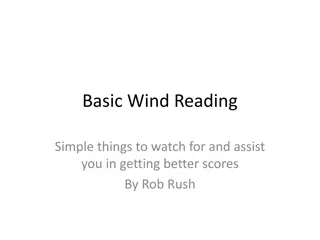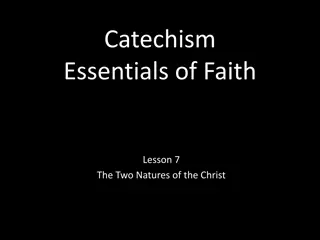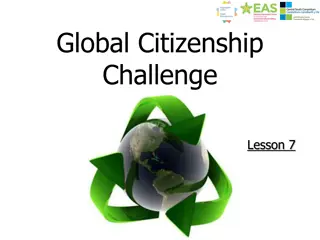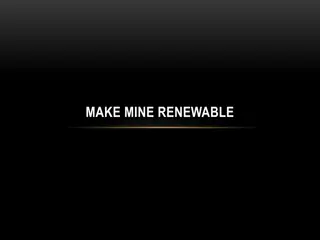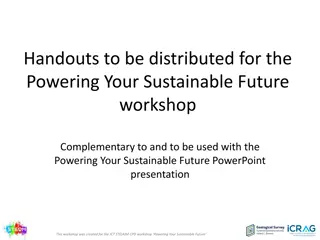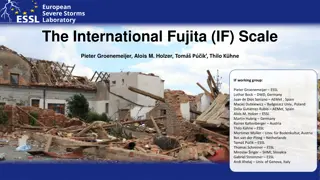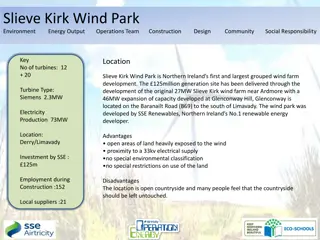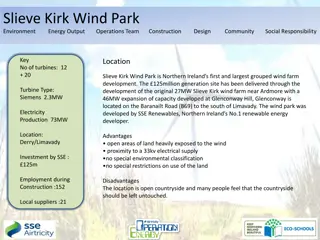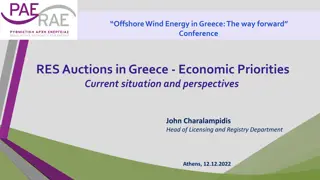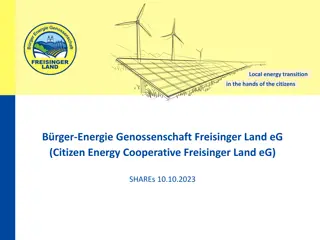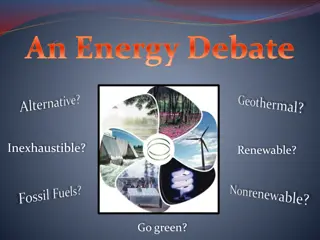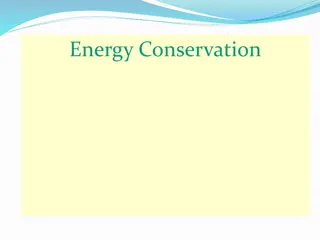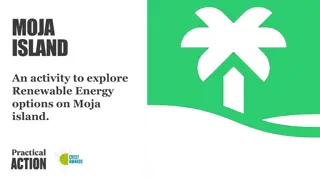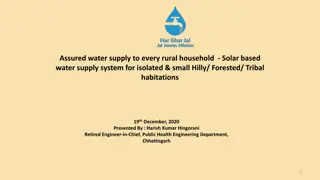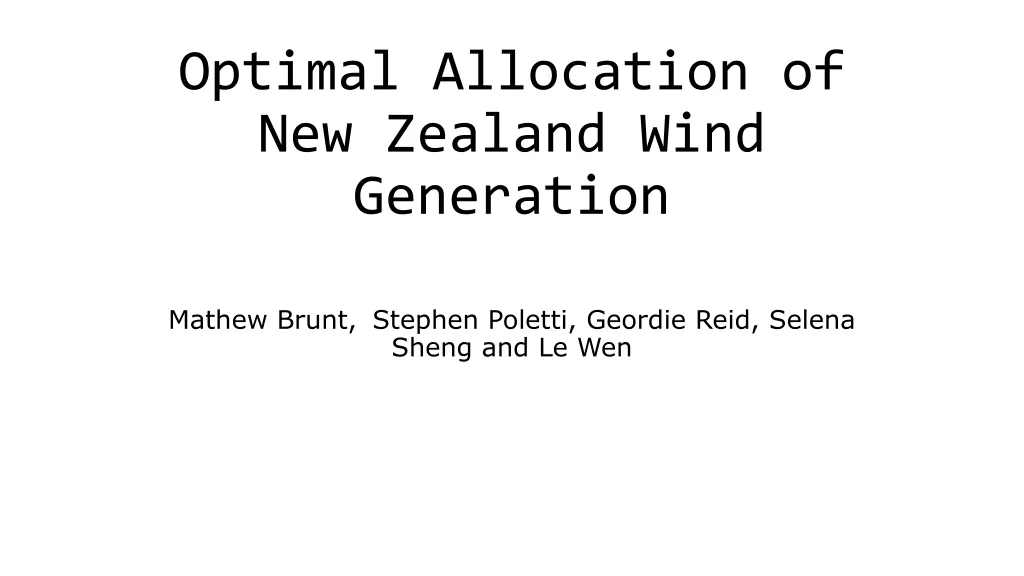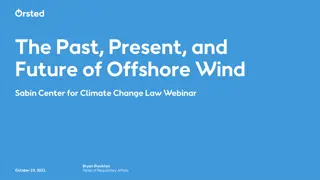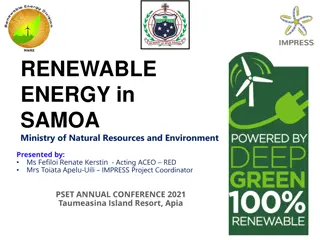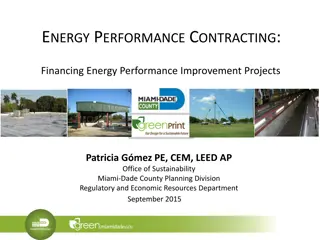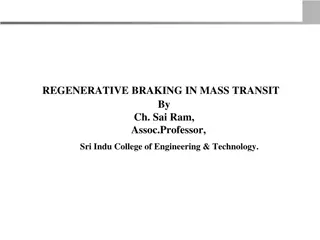Exploring Wind Energy: Harnessing Nature's Power for a Sustainable Future
Wind energy, derived from the movement of air masses caused by solar heating, is a clean and renewable energy source. Wind turbines convert this kinetic energy into mechanical energy, offering a range of unit ratings from small to very large. Wind farms, consisting of turbines, generate electricity, contributing to the global shift towards eco-friendly energy solutions. This article also discusses key terms and definitions related to wind energy, including wind farms, turbine generators, vertical and horizontal axis turbines, and the historical use of wind power in various applications.
Download Presentation

Please find below an Image/Link to download the presentation.
The content on the website is provided AS IS for your information and personal use only. It may not be sold, licensed, or shared on other websites without obtaining consent from the author. Download presentation by click this link. If you encounter any issues during the download, it is possible that the publisher has removed the file from their server.
E N D
Presentation Transcript
Topic WIND ENERGY Presented by Dr. R. R. Mistry Asst. Professor Department of Physics Deogiri College, Aurangabad
WIND ENERGY: Introduction to wind energy:- Wind energy is the kinetic energy associated with movement of large masses of air. These motions results from uneven heating of the atmosphere by the sun, creating temperature, density and pressure differences. It is a clean, cheap and eco-friendly renewable source. The wind energy is supposed to be mechanical energy with the help of a wind turbine. Wind power was used earlier for several centuries for propelling ship, driving windmills, pumping water, irrigation fields and numerous other purposes.
During 1970s and 1980s data regarding wind energy resources has been collected from various sites. During 1980s various types of prototype wind turbine generators have been built. Several wind turbine generators have been installed throughout the world. Unit ratings of wind-turbine generators cover a wide range from 0.5kW classification is as very small (0.5 to 1 kW), small (1 to 15kW ), medium (15 to 200 kW), large (250 to 1000 kW), very large ( 1000 to 6000 kW). to 14kW. The broad
Termsand definition: i) Wind:- Wind is moving air and is caused by differences in air pressure atmosphere. Air under high pressure is moves towards area of low pressure. The greater the difference in pressure, the faster theair flows. ii) Wind Farm (Wind Energy Park): A wind farm or wind park is also called a wind power station or wind power plant, is a group of wind turbines in the same location used to produce electricity. Wind farm are located in the areas having continuous favourablewind. within our
iii)Wind turbine generator unit: an assemble of a wind turbine, gear chain, electrical generator, associated civil works and auxiliaries. iv)Wind turbine Machine):A machine which convert wind power into rotary mechanical power. A wind turbine has aerofoil blades mounted on the rotor. The wind drives the rotor and producers rotary mechanical energy. v)Vertical axis wind turbine (VAWT): When the axis of rotation is perpendicular to the air stream (i.e. vertical ), the turbine is said to be vertical axis wind turbine. The blades rotates around a vertical axis. (Aeroturbine, Wind
vi)Horizontal axis wind turbine (HAWT): When the axis of rotation is parallel to the air stream (i.e. horizontal ), the turbine is said to be horizontal axis wind turbine. The blades rotates around a horizontal axis. Propeller type design has a rotor like the rotor of an aircraft. Propeller type horizontal axis wind turbine has one/two/three blades mounted on a hub. vii)Propeller (Wheel): blades. The blade are set at an angle and twisted (like thread of a screw). viii)Wind Mill: The machinery driven by the wind acting upon sails used chiefly in flat districts for grinding of corn, pumping of wateretc. Revolving shaft with
Typesof wind turbinesgeneratorunits: Wind turbine generator unit consists of the following majorsub assemblies. a) A wind turbine with vertical axis or horizontal axis. b) Gearchain. c) An electrical generator (Synchronous or asynchronous (induction). d) Associated civil works, electrical and mechanical auxiliaries, control panels etc.
The wind turbine generator units convert wind power into electrical power. The ratings of a wind turbine units range between 15 kW to 14 MW. The propeller type horizontal axis wind turbine has a central shaft with a hub and a propeller (wheel). The shaft is mounted on two bearings. The propeller has a few blades with aerofoil. The wind passes through the propeller and gives a circumferential force (torque) and axial thrust. The torque is responsible for converting wind power to rotory mechanical power. The wind generator together form a unit . Several identical units are installed in a wind farm. The total electrical power produced by the wind farm is fed into the distribution network. turbine, gears and
Horizontal axis wind turbine generator unit (HAWT) are manufactured widely. The three blade version is the most popular all over the world for unit ratings from 15 kW to 3 MW. Vertical Axis wind turbine generator units (VAWT) are built commercially manufacturers. Two commercially successful. 1)Darrius wind turbine with configuration. 2)VAWT with H configuration. Very large vertical axis Darrius wind turbine with unit rating 4 MW have been successfully built. The rotor blades of horizontal and vertical wind turbine are designed on aerodynamic principle. by few types of designs are
Monoblade HAWT: The mono-blade wind turbines have lighter rotor and favourable priced. Smallest mono- blade designs are of 15 kW to 30 kW unit rating. These may be used in wind parks or individually for water pumping, battery recharging, power supply system forremote installations. Mono-blade wind equipped with synchronous asynchronous generator. It can be operated as a standalone unit orwith grid connections. Mono- blade wind turbine blades generally pitch controlled. turbine can be or generator
The down wind designs are preferred. Wind vanes are used for orientation to the direction of wind. Due to light weight, the installation and dismantling are easy. Blade lengths are in the range of 15 m to 25 m. Most heights are in the range of 30m and 60 m.
Mono-blade design experience minimum stresses on the bearing and gears. Designs are aerodynamically optimised with high tip speed/ wind speed ratio. Blades are made of metal. Glass reinforced laminated wood, composite carbon fibre etc. to obtain light, economical and strong design. Service life is of about 30 years. Single blade design seems to have lesser scope in higher rating. Two blade and three blade designs are preferred for harnessing more power. plastics,
Theadvantagesof mono blade HAWT: 1) Simple and light construction. 2) Favourable price. 3) Easy to install and maintain. The disadvantages of mono blade HAWT: 1) Teethering control necessary for higher loads. 2) Not suitable for higher power ratings.
Applications: 1) Field irrigation. 2) Sea-waterdesalination plants. 3) Electric power supply for farms and remote loads.
Twin Generator Unit (HAWT): Such units are built in large sizes of unit rating, such as 1 MW, 2 MW and 3 MW. Such high capacity units are installed singly and feed power into the distribution network. Some of the largest wind turbine generator units are twin-blade horizontal axis wind turbine. Cost of a two blade turbine is lesser than that of an equivalent three blade turbine. Weight of two blade rotor is lesser than that of an equivalent three blade turbine. Two blade turbine needs teetering control, the reason for this is as follows: blade Horizontal Wind turbine
The wind speed increases with the height. When rotor is vertical, the blade in upper position is experience a greater force than the blade in lower position. A pivot within the hub allows the rotor to lean backwards to accommodate the extra force without such teetering arrangement, additional fatigue on the main shaft could seriously affect the life of a two bladewind turbine.
The wind turbine generator consists of the following parts; Hub, Blades, Nacelle, Tower, Power cable, Control unit, pitch system, Gear box, Convertor, Yaw system, Generator.
Merits of wind energy: 1) It is renewable energy available freeof cost. 2) It is clean and pollution freeenergy. 3) It will help in supplying electric power to remote areas. 4) Low operating cost. 5) Economically compatible. 6) Ideal choice for rural and remote areas and area which lack otherenergy sources. 7) Wind energy can be used for obtaining mechanical energy for gridding, pumping etc. resulting in energy conservation.
Limitations of wind energy: 1) It has low energy density. 2) Favourable winds are available only in a few geographical locations. 3) Winds are variable, irregular and sometimes dangerous. 4) Direction of wind changes and is never constant or regular. 5) Requires energy storage batteries for supply of continuous power to load. 6) Wind energy can be converted into mechanical energy then to electrical energy. 7) Wind farms require flat, vacant land free from forest. 8) Only in kW and a few MW range. Does not meet the energy needs of large cities and Industry.


